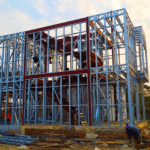The Role of Shear Studs and Deck Sheets in PEB Construction
Pre-engineered buildings (PEBs) have revolutionized the construction industry with their cost-effectiveness, speed of assembly, and design flexibility. A critical aspect of PEB construction is the structural integrity and performance of the building, which relies heavily on components such as shear studs and deck sheets. These elements play a pivotal role in ensuring the stability, strength, and longevity of PEB structures.

Shear Studs: Ensuring Structural Integrity in PEB
1. What Are Shear Studs? Shear studs, also known as shear connectors, are small, cylindrical steel components welded to steel beams and girders. They are essential in composite construction, where they help create a strong bond between the steel framework and the concrete slab. This bond is crucial for the structural integrity and load-bearing capacity of PEBs.
2. Functions of Shear Studs
- Load Transfer: Shear studs facilitate the efficient transfer of loads between the steel beams and the concrete slab, ensuring that both materials work together to bear the load.
- Preventing Slippage: By anchoring the concrete slab to the steel framework, shear studs prevent horizontal slippage, enhancing the overall stability of the structure.
- Improving Composite Action: The integration of shear studs improves the composite action between steel and concrete, resulting in a stiffer and stronger floor system.
3. Installation and Maintenance
- Installation in PEB: Shear studs are typically welded to the top flange of steel beams using specialized welding equipment. The process must be precise to ensure a strong and reliable connection.
- Maintenance: Regular inspections are necessary to check for any signs of wear or damage. Proper maintenance ensures the long-term performance and safety of the structure.
Deck Sheets: Providing Support and Stability in PEB
1. What Are Deck Sheets? Deck sheets, also known as decking or metal deck panels, are corrugated steel panels used to support the concrete slab in floor and roof systems of PEBs. They act as a formwork during concrete pouring and remain in place to provide continuous support.
2. Functions of Deck Sheets
- Formwork for Concrete: During construction, deck sheets serve as a formwork, holding the wet concrete in place until it cures and hardens.
- Structural Support of PEB: Once the concrete is set, the deck sheets work in conjunction with the concrete to provide a strong and stable floor or roof system.
- Load Distribution: Deck sheets help distribute loads across the structure, enhancing the building’s load-bearing capacity and overall stability.
3. Types of Deck Sheets
- PEB Roof Decking: Designed to support roofing materials and provide a base for insulation and waterproofing layers.
- PEB Floor Decking: Used in floor systems to support concrete slabs and create a strong, composite floor structure.
4. Installation and Maintenance
- Installation: Deck sheets are laid over steel beams or joists and secured using fasteners or welds. Proper alignment and secure fastening are crucial to ensure the integrity of the system.
- Maintenance: Regular inspections and maintenance are necessary to check for any signs of corrosion or damage. Proper care extends the lifespan of the deck sheets and the overall structure.
The Synergy Between Shear Studs and Deck Sheets in PEB
The combination of shear studs and deck sheets creates a robust and efficient composite floor system in PEBs. Shear studs enhance the bond between steel and concrete, while deck sheets provide the necessary support and formwork for the concrete slab. Together, they ensure that the structure can withstand various loads and stresses, contributing to the overall safety and performance of the building.
In conclusion, shear studs and deck sheets are indispensable components in PEB construction. They play a critical role in ensuring structural integrity, stability, and longevity, making them vital for the success of any PEB project. By understanding their functions and proper maintenance, architects, contractors, and builders can optimize the performance and durability of pre-engineered buildings.






















